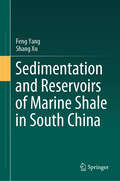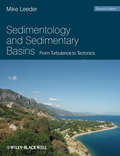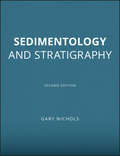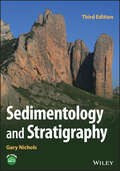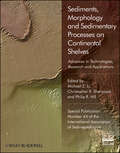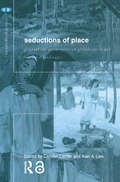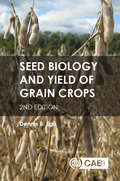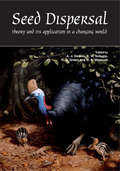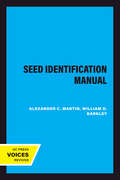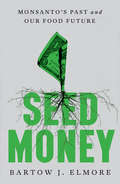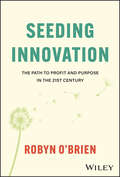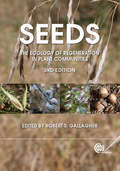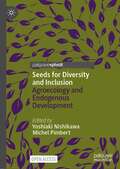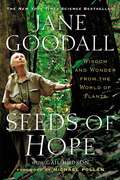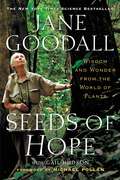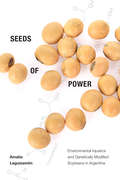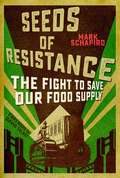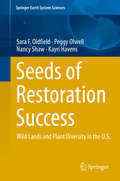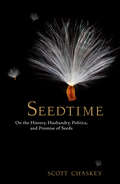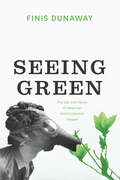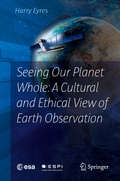- Table View
- List View
Sedimentation and Reservoirs of Marine Shale in South China
by Feng Yang Shang XuThis book systematically investigates the depositional process and reservoir characteristics of organic-rich shales, including (1) The types and development mechanisms of organic-rich shales under ancient ocean and climatic backgrounds. Schematic models are proposed to understand the organic matter enrichment and depletion in shale systems. (2) Microstructure and petrophysical properties. The general lithofacies are recognized and linked to the depositional setting and petrophysical properties. Full-scale pores and fractures are characterized using FE-SEM, gas adsorption, nano-CT and micro-CT scanning. (3) Brittle-ductile characteristics. Rock mechanical properties and in-situ stress are determined. The brittle-ductile transformation of shales is discussed. (4) Shale gas occurrence state and differential enrichment. Gas content and dynamic dissipation over geological time are evaluated using sorption experiments and numerical simulation. Shale gas enrichment model is developed to understand the gas differential accumulation in organic-rich shales. This book can be used for reference by researchers engaged in shale oil and gas geology in both academics and industry.
Sedimentology and Sedimentary Basins
by Mike R. LeederThe sedimentary record on Earth stretches back more than 4.3 billion years and is present in more abbreviated forms on companion planets of the Solar System, like Mars and Venus, and doubtless elsewhere. Reading such planetary archives correctly requires intimate knowledge of modern sedimentary processes acting within the framework provided by tectonics, climate and sea or lake level variations. The subject of sedimentology thus encompasses the origins, transport and deposition of mineral sediment on planetary surfaces.The author addresses the principles of the subject from the viewpoint of modern processes, emphasising a general science narrative approach in the main text, with quantitative background derived in enabling 'cookie' appendices. The book ends with an innovative chapter dealing with how sedimentology is currently informing a variety of cognate disciplines, from the timing and extent tectonic uplift to variations in palaeoclimate. Each chapter concludes with a detailed guide to key further reading leading to a large bibliography of over 2500 entries. The book is designed to reach an audience of senior undergraduate and graduate students and interested academic and industry professionals.
Sedimentology and Stratigraphy
by Gary NicholsThis fully revised and updated edition introduces the reader to sedimentology and stratigraphic principles, and provides tools for the interpretation of sediments and sedimentary rocks. The processes of formation, transport and deposition of sediment are considered and then applied to develop conceptual models for the full range of sedimentary environments, from deserts to deep seas and reefs to rivers.Different approaches to using stratigraphic principles to date and correlate strata are also considered, in order to provide a comprehensive introduction to all aspects of sedimentology and stratigraphy. The text and figures are designed to be accessible to anyone completely new to the subject, and all of the illustrative material is provided in an accompanying CD-ROM. High-resolution versions of these images can also be downloaded from the companion website for this book at:www.wiley.com/go/nicholssedimentology.
Sedimentology and Stratigraphy
by Gary NicholsSedimentology and Stratigraphy Comprehensive textbook on all aspects of sedimentology and stratigraphic principles Sedimentology and Stratigraphy introduces the reader to the subjects and provides tools for the interpretation of sediments and sedimentary rocks, covering the processes of formation, transport, and deposition of sediment and applying them to develop conceptual models for the full range of sedimentary environments, from deserts to deep seas and reefs to rivers. Different approaches to using stratigraphic principles to date and correlate strata are also considered to provide a comprehensive overview of all aspects of sedimentology and stratigraphy. The 3rd edition has been thoroughly revised and updated. The book is now divided into five sections, and the chapters on different depositional settings now provide distinct sections on modern processes and sedimentary rocks. The new edition also features a new set of diagrams and photographs in full colour. Key concepts introduced in Sedimentology and Stratigraphy include: The importance of changes in plant and animal life through time and the effects on characteristics of both marine and continental sedimentary environments The distinction between modern environments and what is preserved in the sedimentary record The role of changing climate, tectonic events and sediment supply in determining the characteristics of deposits in the stratigraphic record Written by a highly qualified author with abundant experience in the field, Sedimentology and Stratigraphy serves as a highly accessible resource for students of geology and related subjects who seek to understand the formation, characteristics, and importance of sedimentary rocks.
Sediments, Morphology and Sedimentary Processes on Continental Shelves
by Christopher R Sherwood Philip R Hill Michael Z LiThe application of multibeam and sediment transport measurement technologies and the adoption of multi-faceted research methodologies have greatly advanced our understanding of the sedimentary processes on continental shelves in the last decade.This book uniquely blends cutting-edge research and state-of-the art review articles that take stock of new advances in multibeam mapping and sediment transport technologies, spatial analysis and modelling, and the applications of these advances to the understanding of shelf sediments, morphodynamics, and sedimentary processes. Case studies are also presented to illustrate the utilization of seabed property and process knowledge in habitat mapping and ocean managementWith its mix of papers focusing on technological advances, integration of shelf morphology and processes, and the application of these advances to coastal and ocean management, this Special Publication volume will serve as a milestone reference for professional marine scientists and as advanced text for students in marine geology, sedimentology and oceanography.This book is part of the International Association of Sedimentologists (IAS) Special Publications.The Special Publications from the IAS are a set of thematic volumes edited by specialists on subjects of central interest to sedimentologists. Papers are reviewed and printed to the same high standards as those published in the journal Sedimentology and several of these volumes have become standard works of reference.
Seductions of Place: Geographical Perspectives on Globalization and Touristed Landscapes (Critical Geographies #Vol. 19)
by Alan A LewThe seductiveness of touristed landscapes is simultaneously local and global, as travelled places are formed and reworked by the activities of diverse, mobile people, in their desires to experience situated, sensuous qualities of difference. Cartier and Lew’s interesting and informative book explores contemporary issues in travel and tourism and human geography, and the complex cultural, political, and economic activities at stake in touristed landscapes as a result of globalization. This book assesses travel and tourism as simultaneously cultural and economic processes, through ideas about place seduction and the formation of landscapes. Throughout, examples are given from urban and environmental touristed landscapes, from major world cities to tropical islands, and chapter contributions include: an analysis of the representational character of landscape and the built environment historic constructions of place seduction the importance of class, racial, and gender dimensions of place how mobility and the seduction of place orient identity formation the environmental impacts of tourism economies. Broad in scope, this book is ideal for social scientists and humanists who are interested in contemporary debates about place studies, mobility, and the located realities of globalization.
Seed Biology and Yield of Grain Crops
by Dennis EgliThis new edition of an established title examines the determination of grain crop yield from a unique perspective, by concentrating on the influence of the seed itself. As the food supply for an expanding world population is based on grain crops harvested for their seeds, understanding the process of seed growth and its regulation is crucial to our efforts to increase production and meet the needs of that population. Yield of grain crops is determined by their assimilatory processes such as photosynthesis and the biosynthetic processes in the seed, which are partly regulated within the seed itself. Providing a timely update in this field and highlighting the impact of the seed on grain crop yields, this book: · Describes all aspects of seed growth and development, including environmental and genetic effects on growth rate and length of the filling period. · Discusses the role of the seed in determining the two main yield components: individual seed weight and number of seeds per unit area. · Uses the concepts and models that have been developed to understand crop management and yield improvement. Substantially updated with new research and further developments of the practical applications of the concepts explored, this book is essential reading for those concerned with seed science and crop yield, including agronomists, crop physiologists, plant breeders, and extension workers. It is also a valuable source of information for lecturers and graduate students of agronomy and plant physiology.
Seed Biology and Yield of Grain Crops, 2nd Edition
by Dennis B. EgliThis new edition of an established title examines the determination of grain crop yield from a unique perspective, by concentrating on the influence of the seed itself. As the food supply for an expanding world population is based on grain crops harvested for their seeds, understanding the process of seed growth and its regulation is crucial to our efforts to increase production and meet the needs of that population. Yield of grain crops is determined by their assimilatory processes such as photosynthesis and the biosynthetic processes in the seed, which are partly regulated within the seed itself. Providing a timely update in this field and highlighting the impact of the seed on grain crop yields, this book: #65533; Describes all aspects of seed growth and development, including environmental and genetic effects on growth rate and length of the filling period. #65533; Discusses the role of the seed in determining the two main yield components: individual seed weight and number of seeds per unit area. #65533; Uses the concepts and models that have been developed to understand crop management and yield improvement. Substantially updated with new research and further developments of the practical applications of the concepts explored, this book is essential reading for those concerned with seed science and crop yield, including agronomists, crop physiologists, plant breeders, and extension workers. It is also a valuable source of information for lecturers and graduate students of agronomy and plant physiology.
Seed Dispersal: Theory and Its Application in a Changing World
by Andrew J. Dennis Eugene W. Schupp Ronda J. Green David A. WestcottFresh concepts in the study of seed dispersal are spurring a host of exciting new answers, answers to old questions, new methods and approaches, and a reinvigoration of the field. Seed Dispersal: Theory and its Application in a Changing World present both recent advances and reviews of current knowledge, demonstrating the vigour and vibrancy of the field.
Seed Identification Manual
by Alexander C. Martin William D. BarkleyThis title is part of UC Press's Voices Revived program, which commemorates University of California Press’s mission to seek out and cultivate the brightest minds and give them voice, reach, and impact. Drawing on a backlist dating to 1893, Voices Revived makes high-quality, peer-reviewed scholarship accessible once again using print-on-demand technology. This title was originally published in 1961.This title is part of UC Press's Voices Revived program, which commemorates University of California Press’s mission to seek out and cultivate the brightest minds and give them voice, reach, and impact. Drawing on a backlist dating to 1893, Voices Revived</DIV
Seed Money: Monsanto's Past And Our Food Future
by Bartow J. ElmoreAn authoritative and eye-opening history that examines how Monsanto came to have outsized influence over our food system. Monsanto, a St. Louis chemical firm that became the world’s largest maker of genetically engineered seeds, merged with German pharma-biotech giant Bayer in 2018—but its Roundup Ready® seeds, introduced twenty-five years ago, are still reshaping the farms that feed us. When researchers found trace amounts of the firm’s blockbuster herbicide in breakfast cereal bowls, Monsanto faced public outcry. Award-winning historian Bartow J. Elmore shows how the Roundup story is just one of the troubling threads of Monsanto’s past, many told here and woven together for the first time. A company employee sitting on potentially explosive information who weighs risking everything to tell his story. A town whose residents are urged to avoid their basements because Monsanto’s radioactive waste laces their homes’ foundations. Factory workers who peel off layers of their skin before accepting cash bonuses to continue dirty jobs. An executive wrestling with the ethics of selling a profitable product he knew was toxic. Incorporating global fieldwork, interviews with company employees, and untapped corporate and government records, Elmore traces Monsanto’s astounding evolution from a scrappy chemical startup to a global agribusiness powerhouse. Monsanto used seed money derived from toxic products—including PCBs and Agent Orange—to build an agricultural empire, promising endless bounty through its genetically engineered technology. Skyrocketing sales of Monsanto’s new Roundup Ready system stunned even those in the seed trade, who marveled at the influx of cash and lavish incentives into their sleepy sector. But as new data emerges about the Roundup system, and as Bayer faces a tide of lawsuits over Monsanto products past and present, Elmore’s urgent history shows how our food future is still very much tethered to the company’s chemical past.
Seeding Innovation: The Path to Profit and Purpose in the 21st Century
by Robyn O'BrienBuild and grow a company ready for the next generation of consumers In Seeding Innovation: The Path to Profit and Purpose in the 21st Century, veteran entrepreneur, award winning author, global strategist, speaker, and Rice University Innovation and Entrepreneurship professor, Robyn O’Brien, delivers an insightful and data driven roadmap to authenticity and smart leadership in the face of accelerating technological, environmental, and social change. In the book, you’ll discover how to build resilience, authenticity, market share and purpose into your business plan and move beyond box-ticking, virtue signaling and one-dimensional metrics, in a way that strengthens your business model, enhances your bottom line, attracts investors, fortifies employee retention, and more.With her characteristic candor and attention to data and deep experience on the frontlines of industry change, Robyn explains how you can transform concepts like paradigm blindness, scarcity, imposter syndrome, rejection, and fear to build durable, lasting, and profitable businesses that integrate social and environmental principles, with courage and integrity to drive long term shareholder and stakeholder value.You’ll also discover how to: Develop a purpose-driven product line that holds strong appeal for new generations of consumers and avoids the ruthless practices associated with PR nightmares and externalized costs Build an iconic company that focuses on integrating meaningful change to inspire customers, investors, and employees and that eschews meaningless press releases and virtue signaling Overcome imposter syndrome and naysayers using the S.T.O.P. Protocol ™ Develop supportive scaffolding and a resilient mindset in order to leverage courage and gain market share Build boards (not echo chambers), why equity and governance matters, and how diversity is good for your bottom line Integrate authentic marketing and storytelling into your brand strategy to drive revenue and capture market share Avoid the dangers of silos, fundraising traps and toxic capital and build a model with value-aligned, informed investors. Spot greenwashing, gender washing, and carbon washing, and more importantly, how to avoid them within your own organization and drive change Address headlines around ESG and DEI metrics in order to meet the needs of asset managers and investors, build successful teams and integrate goals that are central to outperformance and higher returns Gen Z and the modern consumer are looking for companies with authenticity—they want transparency and purpose from brands that are future proofing for the planet they’re inheriting. With this changing consumer focus and mindset emerges an urgent need for emotionally intelligent leadership. Along with profitability, 21st century leaders must focus on environmental stewardship, equity and justice, employee retention, recruiting, collaboration, and emerging other key aspects of modern business.
Seeds
by Robert S GallagherThe 3rd edition of Seeds: The Ecology of Regeneration in Plant Communities highlights the many advances in the field of seed ecology and its relationship to plant community dynamics that have taken place in recent years. The new edition also features chapters on seed development and morphology, seed chemical ecology, implications of climate change on regeneration by seed, and the functional role of seed banks in agricultural and natural ecosystems. The book is aimed at advanced level students and researchers in the fields of seed science, seed ecology and plant ecology.
Seeds for Diversity and Inclusion: Agroecology and Endogenous Development
by Yoshiaki Nishikawa Michel PimbertThis open access book will contribute to a more nuanced debate around seed system resilience that goes beyond the dominant dichotomous conceptualization of seed governance often characterized as traditional vs modern, subsistence vs commercial, or local vs global. While reflecting on the expanding oligopoly in the current seed system, the authors argue that such classifications limit our ability to critically reflect on and acknowledge the diverse approaches through which seed governance is practiced around the world, at various scales, creating a mosaic of dynamic complementarities and autonomies. The authors also highlight the importance of this much needed dialogue through case studies of seed governance approaches and practices found in and around Japan.
Seeds of Hope
by Jane Goodall Gail HudsonRenowned naturalist and bestselling author Jane Goodall examines the critical role that trees and plants play in our world. In her wise and elegant new book, Jane Goodall blends her experience in nature with her enthusiasm for botany to give readers a deeper understanding of the world around us.Long before her work with chimpanzees, Goodall's passion for the natural world sprouted in the backyard of her childhood home in England, where she climbed her beech tree and made elderberry wine with her grandmother. The garden her family began then, she continues to enjoy today. SEEDS OF HOPE takes us from England to Goodall's home-away-from-home in Africa, deep inside the Gombe forest, where she and the chimpanzees are enchanted by the fig and plum trees they encounter. She introduces us to botanists around the world, as well as places where hope for plants can be found, such as The Millennium Seed Bank, where one billion seeds are preserved. She shows us the secret world of plants with all their mysteries and potential for healing our bodies as well as Planet Earth.Looking at the world as an adventurer, scientist, and devotee of sustainable foods and gardening-and setting forth simple goals we can all take to protect the plants around us-Jane Goodall delivers an enlightening story of the wonders we can find in our own backyards.
Seeds of Hope: Wisdom and Wonder from the World of Plants
by Jane Goodall Michael Pollan Gail HudsonRenowned naturalist and bestselling author Jane Goodall examines the critical role that trees and plants play in our world. In her wise and elegant new book, Jane Goodall blends her experience in nature with her enthusiasm for botany to give readers a deeper understanding of the world around us.Long before her work with chimpanzees, Goodall's passion for the natural world sprouted in the backyard of her childhood home in England, where she climbed her beech tree and made elderberry wine with her grandmother. The garden her family began then, she continues to enjoy today. SEEDS OF HOPE takes us from England to Goodall's home-away-from-home in Africa, deep inside the Gombe forest, where she and the chimpanzees are enchanted by the fig and plum trees they encounter. She introduces us to botanists around the world, as well as places where hope for plants can be found, such as The Millennium Seed Bank, where one billion seeds are preserved. She shows us the secret world of plants with all their mysteries and potential for healing our bodies as well as Planet Earth.Looking at the world as an adventurer, scientist, and devotee of sustainable foods and gardening-and setting forth simple goals we can all take to protect the plants around us-Jane Goodall delivers an enlightening story of the wonders we can find in our own backyards.
Seeds of Power: Environmental Injustice and Genetically Modified Soybeans in Argentina
by Amalia LeguizamónIn 1996 Argentina adopted genetically modified (GM) soybeans as a central part of its national development strategy. Today, Argentina is the third largest global grower and exporter of GM crops. Its soybeans—which have been modified to tolerate being sprayed with herbicides—now cover half of the country's arable land and represent a third of its total exports. While soy has brought about modernization and economic growth, it has also created tremendous social and ecological harm: rural displacement, concentration of landownership, food insecurity, deforestation, violence, and the negative health effects of toxic agrochemical exposure. In Seeds of Power Amalia Leguizamón explores why Argentines largely support GM soy despite the widespread damage it creates. She reveals how agribusiness, the state, and their allies in the media and sciences deploy narratives of economic redistribution, scientific expertise, and national identity as a way to elicit compliance among the country’s most vulnerable rural residents. In this way, Leguizamón demonstrates that GM soy operates as a tool of power to obtain consent, to legitimate injustice, and to quell potential dissent in the face of environmental and social violence.
Seeds of Resistance: The Fight to Save Our Food Supply
by David Talbot Mark SchapiroSun. Soil. Water. Seed. These are the primordial ingredients for the most essential activity of all on earth: growing food. All of these elements are being changed dramatically under the pressures of corporate consolidation of the food chain, which has been accelerating just as climate change is profoundly altering the conditions for growing food. In the midst of this global crisis, the fate of our food has slipped into a handful of the world’s largest companies. Food Chained will bring home what this corporate stranglehold is doing to our daily diet, from the explosion of genetically modified foods to the rapid disappearance of plant varieties to the elimination of independent farmers who have long been the bedrock of our food supply.Food Chained will touch many nerves for readers, including concerns about climate change, chronic drought in essential farm states like California, the persistence of the junk food culture, the proliferation of GMOs, and the alarming domination of the seed market and our very life cycle by global giants like Monsanto.But not all is bleak when it comes to the future of our food supply. Food Chained will also present hopeful stories about farmers, consumer groups, and government agencies around the world that are resisting the tightening corporate squeeze on our food chain.
Seeds of Restoration Success: Wild Lands and Plant Diversity in the U.S. (Springer Earth System Sciences)
by Nancy Shaw Kayri Havens Sara F. Oldfield Peggy OlwellThis book provides a general overview of the natural landscapes and vegetation types of the U.S., the key plant species that help define them, the pressures faced by natural ecosystems and the imperative for conservation and restoration. It addresses the policies that have been introduced to manage healthy ecosystems and the practical progress that is being made in restoration. A particular focus is on the production of diverse native plant materials currently required by the National Seed Strategy. Case studies demonstrate how native plant materials are essential to support the conservation of healthy ecosystems with their biodiversity and functions as well as supporting a productive and sustainable agricultural sector and healthy ecosystems for all. The authors are closely connected with major national and international networks of botanic gardens, ecologists and conservation scientists at Board level and through other professional links. Condensing a wide range of current information into a concise format, this book fills a need by experts and informed amateurs interested in the natural environment, including gardeners, botanic garden and protected area visitors, government agencies, the private sector native seed industry, and NGOs.
Seeds: A Natural History
by Carolyn FryFrom the magnificence of a towering redwood to the simple elegance of a tiny dandelion, seed-bearing plants abound on planet Earth. The sheer diversity of plants thriving today is largely thanks to the evolution of the seed, as this made plants resilient to environmental changes by enabling them to await optimum conditions for growth before springing to life. In a time of declining biodiversity, studying seeds is now helping scientists preserve this plant diversity for future generations. With Seeds, Carolyn Fry offers a celebration of these vital but unassuming packages of life. She begins with a sweeping tour through human history, designed to help us understand why we should appreciate and respect these floral parcels. Wheat, corn, and rice, she reminds us, supply the foundations of meals eaten by people around the world. Countless medicines, oils, clothing materials, and building supplies are available only because of the versatility and variety of seed-bearing plants. Fry then provides a comprehensive history of the evolution of seeds, explaining the myriad ways that they have adapted, survived, and thrived across the globe. Delving deeper into the science of seeds, she reveals the fascinating processes of dormancy, reproduction, germination, and dispersal, and showcases the estimable work conservationists are doing today to gather and bank seeds in order to prevent species from going extinct. Enriched by a stunning array of full-color images, Seeds offers a comprehensive exploration of some of the most enduring and essential players in the natural world.
Seeds: The Ecology of Regeneration in Plant Communities
by Robert S. GallagherThis 3rd edition highlights many advances in the field of seed ecology and its relationship to plant community dynamics over recent years. It features chapters on seed development and morphology, seed chemical ecology, implications of climate change on regeneration, and the functional role of seed banks in agricultural and natural ecosystems.
Seedtime: On the History, Husbandry, Politics and Promise of Seeds
by Scott ChaskeyScott Chaskey—working farmer, poet, and spiritual father of the community farming movement—considers "the web of biodiversity and resilience at the heart of our cultural inheritance" by masterfully weaving history, politics, botany, literature, mythology, and memoir into a beautiful and instructive book.It's hard to think of a subject more fundamental to the sustenance of the human race than seeds. Having coevolved with the Earth's plants, insects, and animals, seeds are entwined with the core myths of ancient cultures and the development of human consciousness. Their story remains vitally important today, as the corporations that manufacture GMOs threaten our food security and the future of seed-cultivated agriculture.The stakes, for those concerned with preserving biodiversity and ecological integrity, are high. Balancing a wide view of politics and history, Chaskey alights from life on the farm he has cultivated for 25 years to conjure Gregor Mendel's breeding experiments that yielded our modern understanding of genetics; he also introduces us to several "bioneers," such as the geobotanist Nikolay Vavilov and agriculturalist Cary Fowler, who are preserving global biodiversity through seeds. Integrating scholarship with accessible storytelling, Seedtime is a celebration as well as a call to action urging us to renew our role as citizens of nature, in ecologist Aldo Leopold's phrase, not as conquerors of it.
Seeing Green: The Use and Abuse of American Environmental Images
by Finis DunawayAmerican environmentalism is defined by its icons: the "Crying Indian,” who shed a tear in response to litter and pollution; the cooling towers of Three Mile Island, site of a notorious nuclear accident; the sorrowful spectacle of oil-soaked wildlife following the ExxonValdez spill; and, more recently, Al Gore delivering his global warming slide show in An Inconvenient Truth. These images, and others like them, have helped make environmental consciousness central to American public culture. Yet most historical accounts ignore the crucial role images have played in the making of popular environmentalism, let alone the ways that they have obscured other environmental truths. Finis Dunaway closes that gap with Seeing Green. Considering a wide array of images--including pictures in popular magazines, television news, advertisements, cartoons, films, and political posters--he shows how popular environmentalism has been entwined with mass media spectacles of crisis. Beginning with radioactive fallout and pesticides during the 1960s and ending with global warming today, he focuses on key moments in which media images provoked environmental anxiety but also prescribed limited forms of action. Moreover, he shows how the media have blamed individual consumers for environmental degradation and thus deflected attention from corporate and government responsibility. Ultimately, Dunaway argues, iconic images have impeded efforts to realize--or even imagine--sustainable visions of the future. Generously illustrated, this innovative book will appeal to anyone interested in the history of environmentalism or in the power of the media to shape our politics and public life.
Seeing Our Planet Whole: A Cultural and Ethical View of Earth Observation
by Harry EyresThis book shows how our new-found ability to observe the Earth from "the necessary distance" has wide and profound cultural and ethical implications. First of all, it is the outcome of speculations and investigations of human beings in relation to their home planet carried out over millennia. In particular, it reveals a split between the ancient idea of the Earth as nurturing mother and the more recent conception of the Earth as a neutral resource able to be infinitely exploited by humankind. The 1968 Earthrise photograph, showing the beauty and fragility of the Earth, helped spark a worldwide environmental movement; now the comprehensive coverage of global change provided by satellites has the potential to convince us beyond reasonable doubt of the huge alterations being wrought upon the Earth and its climate system as a result of human actions, and of the need to act more responsibly.
